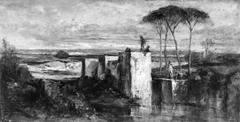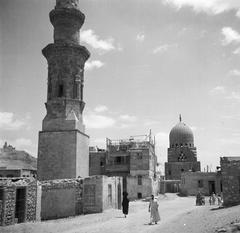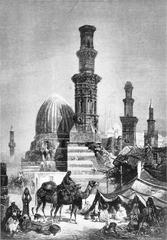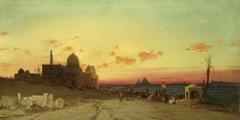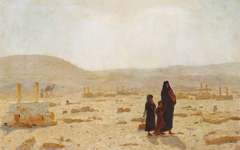
Comprehensive Guide to Visiting شارع الخاصة, Cairo, Egypt
Date: 01/08/2024
Introduction
شارع الخاصة, also known as Shari’a al-Khasah, is a historically rich street nestled in the heart of Cairo, Egypt. Tracing its origins back to the Fatimid dynasty, this street embodies the essence of Cairo’s architectural, cultural, and economic evolution. Established in AD 969 by the Fatimids, شارع الخاصة was designed as a central artery for the newly founded city, a blueprint that has endured through the centuries (Britannica). Today, it stands as a living museum, showcasing a blend of Fatimid, Ayyubid, Mamluk, and Ottoman architectural styles, evident in landmarks such as the Al-Hakim Mosque and the Sabil-Kuttab of Sultan Qaytbay (Sacred Footsteps). Beyond its architectural grandeur, شارع الخاصة has historically been a bustling economic hub, attracting merchants from across the Islamic world. The street’s significance persisted through various eras, including the Ottoman and British periods, each leaving an indelible mark on its landscape (Rare Historical Photos). Today, the street is a UNESCO World Heritage Site, recognized for its cultural and historical importance, with ongoing preservation efforts ensuring its legacy for future generations (Sacred Footsteps). For visitors, شارع الخاصة offers a unique glimpse into Cairo’s past, complemented by modern-day attractions and vibrant cultural activities. This guide aims to provide comprehensive insights into visiting شارع الخاصة, including historical context, practical tips, and essential visitor information.
Table of Contents
- Introduction
- Historical Background of شارع الخاصة
- Visitor Information
- Visitor Tips
- FAQ
- Conclusion
- Call to Action
Historical Background of شارع الخاصة
Early Foundations and Fatimid Era
شارع الخاصة has roots tracing back to the Fatimid dynasty. The Fatimids, who established Cairo in AD 969, laid the foundations for what would become one of the most significant urban centers in the Islamic world. The street itself was part of the grand urban planning that characterized the Fatimid era, designed to serve as a central artery for the newly founded city (Britannica).
Architectural Significance
The architectural landscape of شارع الخاصة is a testament to the various dynasties that ruled Cairo. The street features a blend of Fatimid, Ayyubid, Mamluk, and Ottoman architectural styles. This eclectic mix is evident in the numerous mosques, palaces, and other structures that line the street. For instance, the Fatimid influence is visible in the intricate designs of the Al-Hakim Mosque, while the Mamluk era contributed to the construction of grand palaces and madrasas (Sacred Footsteps).
Economic Hub
Historically, شارع الخاصة served as a bustling economic hub. During the Fatimid period, it was the center of trade and commerce, attracting merchants from across the Islamic world. The street was lined with markets (souks) that sold everything from spices and textiles to gold and silver. This economic activity continued through the Ayyubid and Mamluk periods, solidifying the street’s reputation as a commercial powerhouse (Britannica).
Ottoman Influence
The Ottoman era brought further changes to شارع الخاصة. The Ottomans, who ruled Egypt from the 16th to the early 20th century, left their mark through the construction of sebils (public fountains) and other public works. These structures not only served practical purposes but also added to the street’s aesthetic appeal. The Ottoman influence is particularly evident in the design of the Sabil-Kuttab of Sultan Qaytbay, a beautiful example of Ottoman architecture (Sacred Footsteps).
British Occupation and Modernization
The British occupation of Egypt in the late 19th and early 20th centuries brought about significant changes to شارع الخاصة. The British introduced modern infrastructure, including street lighting and public transportation, which transformed the street into a more modern urban space. However, this period also saw the imposition of foreign control over Egypt’s economy, leading to increased national debt and social unrest (Rare Historical Photos).
Post-Independence Era
Following Egypt’s independence in 1952, شارع الخاصة underwent further transformations. The new government, led by President Gamal Abdel Nasser, sought to rid Cairo of its colonial past. This included renaming streets and buildings to reflect Egypt’s newfound national identity. Despite these changes, شارع الخاصة retained its historical significance and continued to be a vital part of Cairo’s urban fabric (Wikipedia).
Preservation Efforts
In recent years, there have been concerted efforts to preserve the historical and architectural heritage of شارع الخاصة. The street has been designated as a UNESCO World Heritage Site, recognizing its importance as a cultural and historical landmark. Restoration projects have been undertaken to preserve the street’s numerous historic buildings, ensuring that future generations can appreciate its rich history (Sacred Footsteps).
Cultural Significance
شارع الخاصة is not just a historical and architectural marvel; it is also a cultural hub. The street is home to numerous cultural institutions, including museums, art galleries, and cultural centers. These institutions host a variety of events, from art exhibitions to cultural festivals, making the street a vibrant center of cultural activity in Cairo (Britannica).
Visitor Information
Visiting Hours and Tickets
- Visiting Hours: شارع الخاصة is accessible at all times, but specific attractions along the street may have their own operating hours, typically from 9 AM to 5 PM.
- Tickets: Entrance to the street itself is free, but some attractions may charge a nominal fee. It’s advisable to check the official websites of specific sites for the latest ticket prices.
Guided Tours
Consider hiring a knowledgeable guide to fully appreciate the historical and architectural significance of the street. Guided tours can be arranged through various tour operators in Cairo or directly at major attractions along the street.
Photographic Spots
شارع الخاصة offers numerous picturesque spots for photography. Key locations include the Al-Hakim Mosque, the Sabil-Kuttab of Sultan Qaytbay, and the various souks. Early morning or late afternoon light provides the best conditions for stunning photographs.
Nearby Attractions and Accessibility
- Nearby Attractions: The street is located near other significant historical sites, including the Al-Azhar Mosque, Khan El Khalili Bazaar, and the Cairo Citadel.
- Accessibility: شارع الخاصة is easily accessible by public transportation, including buses and taxis. For a more immersive experience, consider walking or renting a bicycle.
Visitor Tips
For tourists visiting شارع الخاصة, there are several tips to ensure a memorable experience:
- Timing: The best time to visit is during the cooler months, from October to April, to avoid the extreme heat of the summer.
- Guided Tours: Consider hiring a knowledgeable guide to fully appreciate the historical and architectural significance of the street.
- Local Etiquette: Dress modestly and respect local customs, especially when visiting religious sites.
- Safety: Be cautious of pickpockets and avoid isolated areas, especially at night.
- Shopping: Bargain at local markets but be wary of overpriced items in tourist shops (Araioflight).
FAQ
Q: What are the visiting hours for شارع الخاصة?
A: شارع الخاصة is accessible at all times, but specific attractions along the street may have their own operating hours, typically from 9 AM to 5 PM.
Q: Are there any entrance fees for شارع الخاصة?
A: Entrance to the street itself is free, but some attractions may charge a nominal fee. It’s advisable to check the official websites of specific sites for the latest ticket prices.
Q: Is شارع الخاصة suitable for photography?
A: Yes, شارع الخاصة offers numerous picturesque spots for photography. Key locations include the Al-Hakim Mosque, the Sabil-Kuttab of Sultan Qaytbay, and the various souks. Early morning or late afternoon light provides the best conditions for stunning photographs.
Q: What is the best time of year to visit شارع الخاصة?
A: The best time to visit is during the cooler months, from October to April, to avoid the extreme heat of the summer.
Conclusion
شارع الخاصة stands as a living testament to Cairo’s rich and diverse history. From its origins in the Fatimid era to its modern-day significance, the street encapsulates the cultural, economic, and architectural evolution of one of the world’s oldest cities. For visitors, it offers a unique glimpse into the past, making it an essential part of any trip to Cairo. Be sure to explore nearby attractions, respect local customs, and take plenty of photos to capture the unforgettable experience.
Call to Action
Don’t miss out on any updates or tips for exploring Cairo! Download the Audiala mobile app, check out other related posts, and follow us on social media for more insights and travel guides.
References
- Cairo. Britannica. Retrieved from Britannica
- Walking through a thousand years of history: al-Muizz street, Cairo. Sacred Footsteps. Retrieved from Sacred Footsteps
- Old Cairo Pictures. Rare Historical Photos. Retrieved from Rare Historical Photos
- A first-timers guide to Cairo, Egypt. Scenic Route Traveler. Retrieved from Scenic Route Traveler
- Essential Egypt travel tips. The Intrepid Guide. Retrieved from The Intrepid Guide
- Things to know before traveling to Egypt. Lonely Planet. Retrieved from Lonely Planet
- First-timers guide to visiting Cairo. Magnificent World. Retrieved from Magnificent World
- Travelling to Egypt: Travel tips to know before you go. Araioflight. Retrieved from Araioflight
